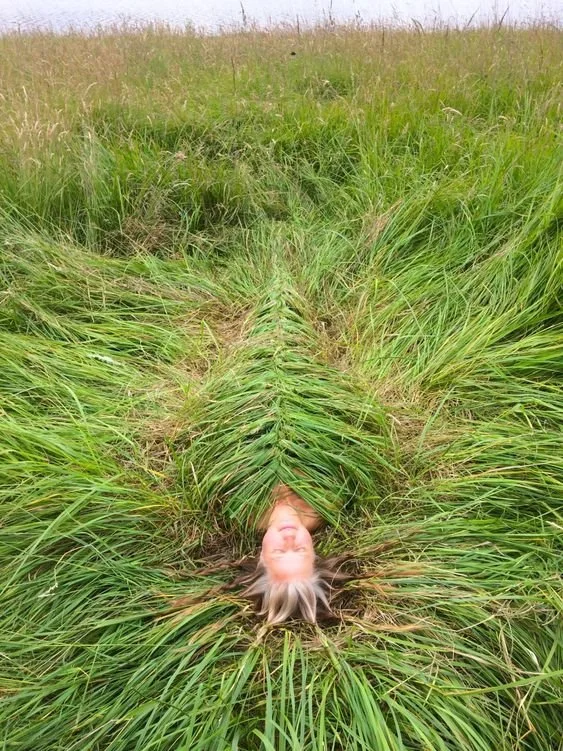Dream Journaling Practice
For this 40-day practice we will focus on Constructing Our Mythic Identity from our Dreams.
For this practice you will need:
a remembered dream
pen and journal
Dreams as Myths
Each morning you are going to create an “I” statement (for example, “I am” or “I can”) based on a particular feature of your dream that calls to you.
This feature could be a part of your personal experiencing of the dream, for example if you were breathing underwater, you could write “I can breathe underwater”, but you are also invited as you recall the dream to take on any part of the dream as yourself.
For example, if the landscape stood out to you, feel free to become that landscape, and create your “I” statement from its perspective.
Try to expand your awareness with the possibility of taking on all parts of the dream as yourself.
Day by day you will compile a list of your “I” statements based on your remembered dream, and by the end of this cohort you will have compiled a memory palace not only of your dreams but also of your new mythic self.
By identifying with the part of ourselves that experiences the dream, or by identifying with the details of the dream itself, we can expand our sense of selfhood to include the world of eternal form, thus re-connecting with the mythic world and our place in it.
Remembering Your Dreams
Memory is a muscle. Anyone can remember dreams and there is no secret or short cut; there is simply the practice of recording. To start remembering your dreams, you must record them immediately upon waking. You will find this becomes easier and easier the more you practice. Maintaining this muscle is the key to your success.
If you need help remembering your dreams, try the following ritual:
With a pen and paper, write down by hand your dream from last night, or the last dream you remember, in as much detail as possible. If you cannot recall any dream, let an interesting or notable memory surface, and write that down in detail. This memory could be one from childhood, a memory of travel, a beautiful place in nature, or somewhere that inspires you. Anything that comes to you right now will do. It’s important that you write by hand to create a mind body connection.
Finish by writing down the intention “tonight, I will remember my dreams” (or make up your own version).
As you close your eyes to fall asleep, you may recall this dream or memory once more, and also repeat your intention. After a minute or so, feel free to let your mind relax and transition into sleep.
When you wake up, stay still and let the details of your dream resurface. If they do not come back right away, give yourself a few minutes and stay focused on remembering your dream. Try not to get distracted by the waking world. I like to ask myself “what was I just doing?” while I lay still and let the details come back.
When you’re ready, open your eyes and record your dream right away. I use Notes on my phone, but any medium you like is fine – pen and paper, phone, computer, or voice recording. If you’re using your phone, consider putting it in airplane mode before bed so that you are not distracted with notifications when you go to record your dream.
If you do not remember anything from your dreams last night, record something anyways! Write down your stream of consciousness, how you are feeling, what’s on your mind, etc. This is a great way to rehearse and prepare yourself for when you catch a dream, and an important step to begin your practice.
If you need extra help, contact me directly – yourstruly@dreampartyhotel.com
Notes
Alarms are not ideal for dream recall. If you must wake up with an alarm, try this – set your alarm, and also ask your body to wake you up 15 minutes before your alarm time. Although very simple, this works surprisingly well.
Weed! If you’re smoking weed regularly and can’t remember your dreams… it’s the weed.
Once you get into the habit of remembering your dreams, you may choose to make any intention you wish before bed (or not).
Myth serves as a crucial compass…
…guiding us through the intricate terrain of existence, providing a framework for understanding the deeper currents of life and one's place within it.
Our earliest ancestors shaped not only special occasions but their mundane lives and routines around their mythologies.
From sleeping to eating to communal gatherings, all parts of life were guided by a connection to something greater—a mythic identity. They understood themselves not just as mere individuals but as embodiments of a larger essence; the details of which could be accessed through visions and dreams.
Dreams offer a direct portal to the world behind the world, to the mythic time where archetypal forces shape the contours of existence. By recalling and integrating dream experiences we have the chance to rekindle the flame of real myth for our lives.

“I am a stag: of seven tines,
I am a flood: across a plain,
I am a wind: on a deep lake,
I am a tean the Sun lets fall,
I am a hawk: above the cliff,
I am a thorn: beneath the nail,
I am a wonder: among flowers,
I am a wizard: who but I
Sets the cool head aflame with smoke?
I am a spear: that roars for blood,
I am a salmon: in a pool,
I am a hire : from paradise,
I am a hill: where poets walk,
I am a boar: ruthless and red,
I am a breaker: threatening doom,
I am a tide: that drags to death,
I am an infant: who but I
Peeps from the unhewn dolmen arch ?
I am the womb: of every holt,
I am the blaze: on every hill,
I am the queen: of every hive,
I am the shield: for every head,
I am the tomb: of every hope. “
Song of Amergin







